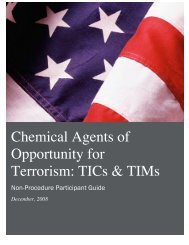Spring 2007 - American College of Medical Toxicology
Spring 2007 - American College of Medical Toxicology
Spring 2007 - American College of Medical Toxicology
You also want an ePaper? Increase the reach of your titles
YUMPU automatically turns print PDFs into web optimized ePapers that Google loves.
acmt newsletter • spring <strong>2007</strong><br />
TOXICOLOGY IMAGES OF INTEREST<br />
Ron Kirschner, MD, FACMT<br />
These seeds were being prepared for planting to grow ornamental<br />
plants when one was eaten by a family member who confused<br />
it for an edible nut. Six hours later he developed vomiting,<br />
diarrhea, and painful myalgias and went to the ED. At that time,<br />
he was noted to be tachycardic, with a heart rate <strong>of</strong> 140 beats per<br />
minute, and he had a normal blood pressure and mental status.<br />
Laboratory work was remarkable for an anion gap <strong>of</strong> 20 mEq/L,<br />
creatinine <strong>of</strong> 3.6 mg/dL, ALT 76 U/L, and WBC <strong>of</strong> 19,000/µL.<br />
He was admitted to the <strong>Toxicology</strong> Unit where he was treated<br />
with IV fluids, analgesics, and anti-emetics. Within 24 hours his<br />
symptoms and laboratory abnormalities resolved, and he was<br />
discharged home.<br />
The castor bean (its not a true bean) is not native to the United<br />
States, but is <strong>of</strong>ten grown as an ornamental plant. It is still widely<br />
used in the production <strong>of</strong> castor oil. The seeds have an attractive<br />
appearance (Ricinus in Latin means tick) that may prompt<br />
children or uninformed adults to ingest them. This plant grows<br />
as an annual to more than 10 feet. The large, lobed leaves may<br />
be 3 feet across, and have a green to red/purple coloration. Spiny<br />
fruits form in clusters along spikes; these hold three seeds each<br />
(see image). 2<br />
The pulp <strong>of</strong> the seeds contains ricin, a water soluble protein<br />
composed <strong>of</strong> two polypeptide chains that is one <strong>of</strong> the most<br />
potent plant toxins known. The B chain binds to glycoproteins<br />
on animal cell surfaces. Once the protein enters the cell by endocytosis,<br />
the A chain irreversibly binds to eukaryotic ribosomes,<br />
interrupting protein synthesis. When delivered parenterally,<br />
ricin is highly toxic, with an LD 50 in mice <strong>of</strong> 5-10 µg/kg. In<br />
1978 Bulgarian dissident Georgi Markov was assassinated by<br />
injection <strong>of</strong> a small metal pellet that investigators believe contained<br />
ricin. The lethal dose for ingested ricin is approximately<br />
1,000-fold higher. 1<br />
The ricin content <strong>of</strong> castor seeds is variable, but has been reported<br />
to range from 1% - 5%. The seeds are unlikely to cause toxicity<br />
unless chewed, breaking the hard seed coat. 3 The onset <strong>of</strong><br />
symptoms following ingestion typically ranges from 4 to 10<br />
hours. Initial symptoms include vomiting, diarrhea and crampy<br />
abdominal pain. Laboratory evaluation may show leukocytosis,<br />
followed by hepatic injury and renal failure as the premonitory<br />
signs <strong>of</strong> multisystem organ failure. Treatment is entirely supportive.<br />
Activated charcoal may be helpful to reduce systemic<br />
absorption <strong>of</strong> ricin, though its effectiveness is unproven.<br />
Following castor bean ingestion, most patients recover with<br />
fluid and electrolyte replacement. 4 There is no specific antidote.<br />
References<br />
1. Audi J, Belson M, Patel M, Schier J, Osterloh J. Ricin poisoning:<br />
A comprehensive review. JAMA 2005;294:2342–2351.<br />
2. Nelson LS, Shih RD, Balick MJ. Handbook <strong>of</strong> Poisonous and<br />
Injurious Plants, 2 nd Edition. <strong>Spring</strong>er/New York Botanical<br />
Garden. New York, NY. <strong>2007</strong><br />
3. Aplin PJ, Eliseo T. Ingestion <strong>of</strong> castor oil plant seeds. Med J<br />
Aust 1997;167:260–261.<br />
4. Challoner JR, McCarron MM: Castor bean intoxication. Ann<br />
Emerg Med 1990; 19: 1177.<br />
Ron Kirschner, MD<br />
<strong>Medical</strong> <strong>Toxicology</strong> Fellow<br />
Pinnacle <strong>Toxicology</strong> Center/Pennsylvania State University<br />
ACMT members are welcome to submit interesting images representing medical<br />
toxicology for publication in future ACMT newsletters. Please include a brief<br />
description <strong>of</strong> the images. Submissions may be sent electronically to<br />
info@acmt.net.<br />
The ACMT, as part <strong>of</strong> a cooperative agreement with ATSDR, maintains the Internet<br />
Library <strong>of</strong> Images in <strong>Toxicology</strong> in the Member’s Only section <strong>of</strong> www.acmt.net.<br />
ACMT members are encouraged to consider contributing images to this library.<br />
Email info@acmt.net for more information.<br />
5
















